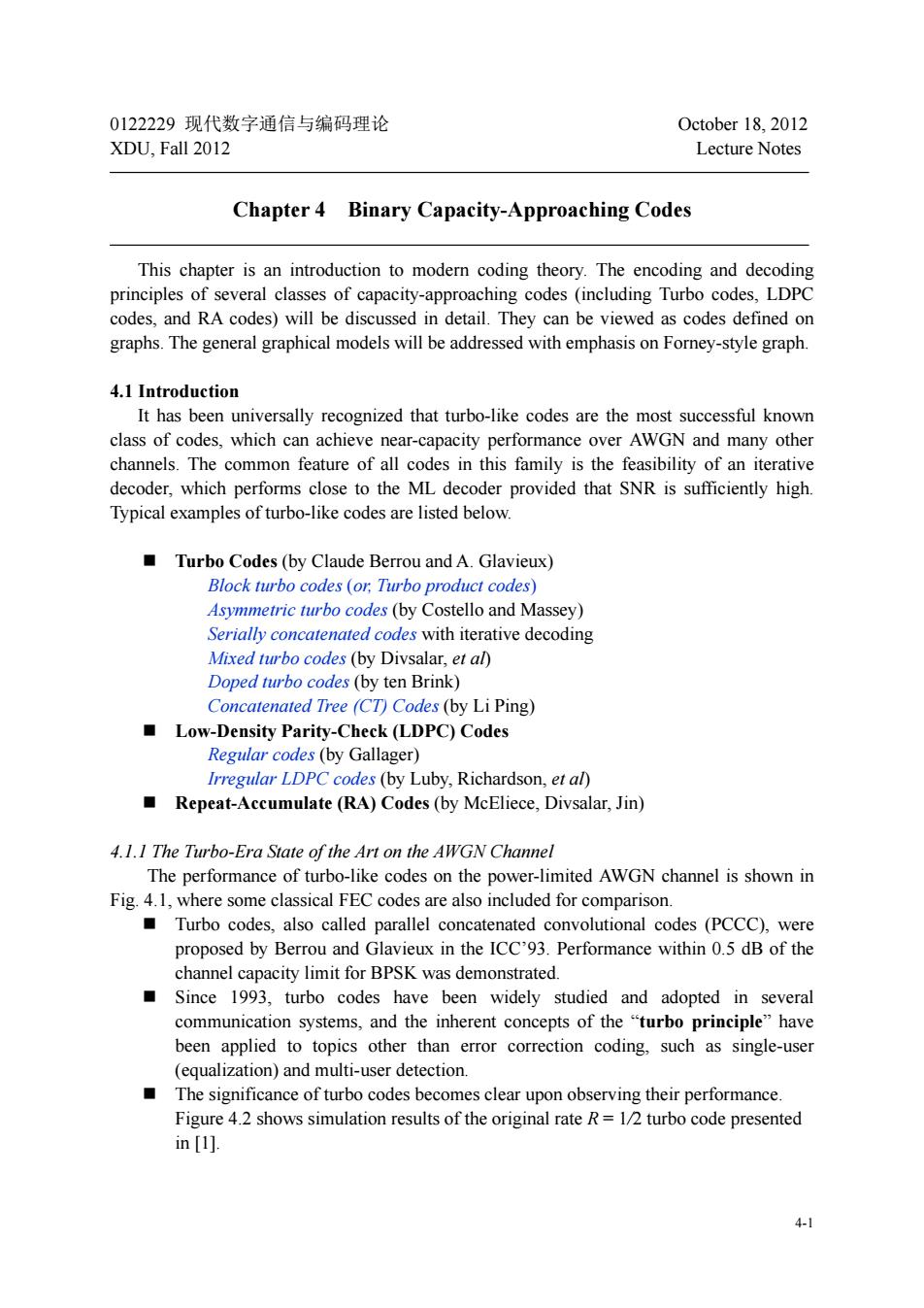正在加载图片...

0122229现代数字通信与编码理论 October 18,2012 XDU,Fall 2012 Lecture Notes Chapter 4 Binary Capacity-Approaching Codes This chapter is an introduction to modern coding theory.The encoding and decoding ngcod(including Trb cd LDPC as codes defined on graphs.The general graphical models will be addressed with emphasis on Forney-style graph. 4.1 Introduction It has been universally recognized that turbo-like codes are the most successful known class of codes,which shes The common feature of all codes in this family is the feasibiliy of n can achieve near-capacity decoder,which performs close to the ML decoder provided that SNR is sufficiently high. Typical examples of turbo-like codes are listed below. Turbo Codes(by Claude Berrou and A.Glavieux) Block turbo codes (or.Turbo product codes) Asvmnmetric turbo codes (by Costello and Massev) Serially concatenated codes with iterative decoding Mixed turbo codes (by Divsalar,et al) Doped turbo codes (by ten Brink) Concatenated Tree(CT Codes(by LiPing) Low-Density Parity-Check(LDPC)Codes Regular codes (by Gallager) Irregular LDPC codes (by Luby,Richardson,et al) Repeat-Accumulate(RA)Codes(by McEliece,Divsalar,Jin) 4.1.1 The Turbo-Era State of the Art on the AWGN Channel The performance of turbo-like codes on the power-limited AWGN channel is shown in Fig.4.1,where some classical FEC codes are also included for comparison. Turbo codes.also called parallel concatenated convolutional codes (PCCC)were proposed by Berrou and Glavieux in the ICC93.Performance within 0.5 dB of the channel capacity limit for BPSK was demonstrated. Since 1993,turbo codes have been widely studied and adopted in several communication systems,and the inherent concepts of the "turbo prineiple"have been applied to topics other than error correction coding.such as single-user The significance of turbo codes upon observing their performance Figure 4.2 shows simulation results of the original rate R=1/2 turbo code presented in [1]. 4.1 4-1 0122229 现代数字通信与编码理论 October 18, 2012 XDU, Fall 2012 Lecture Notes Chapter 4 Binary Capacity-Approaching Codes This chapter is an introduction to modern coding theory. The encoding and decoding principles of several classes of capacity-approaching codes (including Turbo codes, LDPC codes, and RA codes) will be discussed in detail. They can be viewed as codes defined on graphs. The general graphical models will be addressed with emphasis on Forney-style graph. 4.1 Introduction It has been universally recognized that turbo-like codes are the most successful known class of codes, which can achieve near-capacity performance over AWGN and many other channels. The common feature of all codes in this family is the feasibility of an iterative decoder, which performs close to the ML decoder provided that SNR is sufficiently high. Typical examples of turbo-like codes are listed below. Turbo Codes (by Claude Berrou and A. Glavieux) Block turbo codes (or, Turbo product codes) Asymmetric turbo codes (by Costello and Massey) Serially concatenated codes with iterative decoding Mixed turbo codes (by Divsalar, et al) Doped turbo codes (by ten Brink) Concatenated Tree (CT) Codes (by Li Ping) Low-Density Parity-Check (LDPC) Codes Regular codes (by Gallager) Irregular LDPC codes (by Luby, Richardson, et al) Repeat-Accumulate (RA) Codes (by McEliece, Divsalar, Jin) 4.1.1 The Turbo-Era State of the Art on the AWGN Channel The performance of turbo-like codes on the power-limited AWGN channel is shown in Fig. 4.1, where some classical FEC codes are also included for comparison. Turbo codes, also called parallel concatenated convolutional codes (PCCC), were proposed by Berrou and Glavieux in the ICC’93. Performance within 0.5 dB of the channel capacity limit for BPSK was demonstrated. Since 1993, turbo codes have been widely studied and adopted in several communication systems, and the inherent concepts of the “turbo principle” have been applied to topics other than error correction coding, such as single-user (equalization) and multi-user detection. The significance of turbo codes becomes clear upon observing their performance. Figure 4.2 shows simulation results of the original rate R = 1/2 turbo code presented in [1]